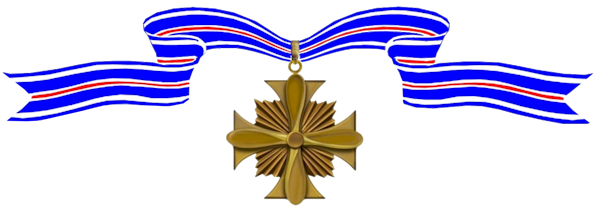The President of the United States of America takes pleasure in presenting the Silver Star to Commander Gordon H. Smith, United States Navy, for conspicuous gallantry and intrepidity in connection with military operations against the enemy as flight leader of two divisions of propeller-driven attack aircraft on 6 and 7 November 1965. Responding to a call for help to search for several downed U.S. Air Force airmen, Commander Smith led his flight to the scene, transmitting missile envelopes and known anti-aircraft positions. Despite approaching darkness and heavy enemy fire, he remained in the area and led a rescue helicopter to the exact position of one of the airmen. During the rescue, he suppressed all enemy activity in the area by cannon fire. Low on fuel, and flying through severe thunderstorms during his return to the carrier, he landed with less than five minutes of fuel remaining. The next morning, he returned to the area, re-established contact with another airman and, when the rescue helicopter was severely damaged by enemy fire, directed it to a suitable landing site on a mountain top.

Awards Received
-

Silver Star
-

Distinguished Flying Cross
-

Distinguished Flying Cross
-

Distinguished Flying Cross
-
Silver Star

All Hands (May 1967) -
Distinguished Flying Cross

All Hands (July 1967)The President of the United States of America takes pleasure in presenting a Gold Star in lieu of a Second Award of the Distinguished Flying Cross to Commander Gordon H. Smith, United States Navy, for extraordinary achievement while participating in aerial flight as the flight leader of four-aircraft night strike over North Vietnam on 16 August 1965. Commander Smith navigated his flight to the target area, exposing himself to enemy anti-aircraft fire, descended alone and illuminated the target. He then maneuvered his aircraft directly over the target area and dropped his first bomb, which caused a large barracks building to burst into flames. Despite intense anti-aircraft fire, he repeatedly led his flight in boldly executed bombing attacks, causing numerous secondary explosions and leaving the entire area on fire. Subsequent intelligence confirmed destruction of huge quantities of enemy supplies and eight large buildings, with severe damage to numerous other buildings.
-
Distinguished Flying Cross

All Hands (July 1967)The President of the United States of America takes pleasure in presenting a Second Gold Star in lieu of a Third Award of the Distinguished Flying Cross to Commander Gordon H. Smith, United States Navy, for extraordinary achievement while participating in aerial flight in connection with military operations against the enemy while conducting the rescue of a downed pilot deep in North Vietnam on 12 July 1966. Commander Smith led his section to the scene of the downed pilot. Over enemy territory for one hour against one surface-to-air missile firing, seventeen MiG alerts and heavy ground fire, he calmly called for the rescue helicopter, coordinated the replacement and aerial refueling of an on-scene jet combat air patrol and provided close cover fore the downed pilot. After the pilot was picked up, Commander Smith preceded the rescue element, deliberately drawing enemy ground fire upon himself so the rescue element could get out of enemy territory safely.
-
Distinguished Flying Cross

All Hands (July 1967)The President of the United States of America takes pleasure in presenting the Distinguished Flying Cross to Commander Gordon H. Smith, United States Navy, for extraordinary achievement while participating in aerial flight in connection with military operations against the enemy during a search and rescue flight deep in hostile territory on 17 October 1965. When notified of a downed F-4B aircraft, Commander Smith proceeded to the scene, maneuvering his section through the surface-to-air missile envelope and flying over known anti-aircraft positions at low altitudes en route. Two downed pilots were sighted in a nearly inaccessible location along a ridge line. Though he encountered periodic medium and light anti-aircraft and continuous small arms fire, Commander Smith remained in the area for two hours and, when visual contact with the downed pilots was lost, made repeated low passes. With a low fuel state necessitating departure of the helicopter, Commander Smith made ten or more search passes before retiring from the are, providing rear cover protection for the helicopter.

